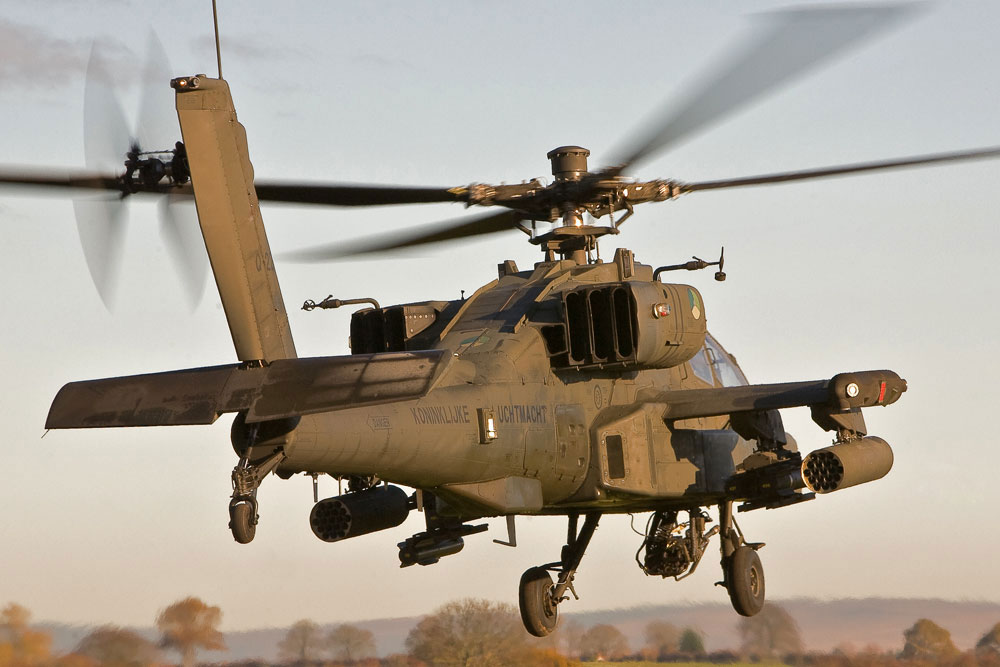|
| Over the past few years the Royal Netherlands Air Force have deployed to Carlisle for their biannual exercise TAC Blaze. Their latest deployment which arrived at Carlisle on the 1st November was under the banner Helicopter Weapons Instructors Course Ė Electronic Warfare (HWIC-EW). This was to be a much larger exercise than any of the previous TAC Blaze exercises held in the area, involving some 270 personnel, 170 from the Air Force and 100 from the Army. |
|
|
||
 |
 |
 |
|
Primarily the HWIC-EW course is to promote flight crews from Section leaders to Instructors, however the RNLAF skilfully integrated a variety of other training, combining both Air Force and the Army which would coincide with the HWIC-EW. Along with its flying crews RNLAF had sent, Load Masters, Communications & Mobile Air Operative Team (MOAT) these are the ground crews that ensure that loads are fit to fly and are properly slung when fastened beneath the aircraft. All the units were tested under battlefield conditions. The Communications team brought with them a pair of Mobile Ground-to-Air Radar Jamming System units to practice jamming techniques. The MOAT personnel and Load Masters integrated their expertise to enhance their aircraft loading skills. Also involved but not being evaluated were the Technicians, Handlers and Refuelerís. These trades ensured that aircraft were kept airworthy and that returning aircraft were turned around promptly made ready for the next missions. From the Army platoons from the 11th Air Mobile Brigade were deployed. Their involvement was to utilise the Helicopters as much as possible and were able to fly on most of the missions undertaken. Their training would be the Air Mobileís forte of operating from Helicopters, embarking, deplaning and setting up Landing Zones in hostile territory. They made their camp on Carlisle airfield and were totally self sufficient throughout the two weeks exercise. The HWIC course in all takes 13 weeks for crews to complete which break down with 1 week of Search & Rescue, 1 week of live weapons firing, 4 weeks of Electronic Warfare the other 7 taken up by general handling. Due to the Netherlands lack of facilities their Armed Forces have to rely on NATO training facilities this involves flying to Germany where they complete the live firing stage and to Spadeadame for the Electronic stage. At Spadeadam flight crews would be exposed to all the threats that a battlefield would hold for a pilot, be that the pilot of an attacking, transport or casivac helicopter. The range at Spadeadam can simulate any threat likely to be encountered by aircrews in hostile conditions in order for them to practice maneuvers and tactics to avoid them.
|
 |
|
This latest deployment began with vehicles and
ground assets arriving by ferry followed by their troops and personnel who
arrived via Newcastle onboard a DC10 of the RNLAF. Once the Forward
Operating Base was set up Three AS532 Cougar and one C47 Chinook of
Netherlands
Defense Helicopter Command
from their base at Gilze Rijen. These were joined the following day by three
AH64 Apacheís.
In torrential rain operations began with the Army separating into Red & Blue squads, the Red squad being driven to the Spadeadam range where they were to take up positions and play the opposing force. The Blue squad embarked onto two of the AS532 and the C47 joined by the three AH64ís they launched and headed to the Spadeadam range. Over the next ten days scenarios like these were played out on occasions with units from the RAF and the Army Air Corps linking up playing both Red & Blue forces in various situations. Most of the missions for the course were flown on the Spadeadam range but the occasional mission would use the nearby Kirkbride airfield. Joining forces with 301 Sqnís AH64ís of 9 Regiment Army Air Corps would share the target acquisitions on the battle field. 100 Sqn Hawks would play the role of attacking enemy aircraft and 12 Sqn GR4ís would bomb targets that had been acquired by the RNLAF helicopter crews. During the two weeks that the course and exercises took place the weather was to play its part with high winds, rain and snow. As bad as this was it only prevented the cancellation of two missions and didnít prevent the course and exercise being completed on time. A tribute to all involved. |
 |
|
|
|
|
The shoulder patch worn by the Weapons Instructors shows three blades spinning indicating that it is a Helicopter course and each blade represents the three types of Helicopters (AS532, C47 & AH64) involved on the HWIC course.
|


